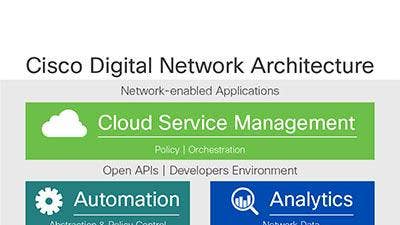Cisco Americas Channel Chief Snyder On Preserving Partner Profitability While Navigating A New IT Landscape
"Partners will tell you that Cisco programs are the most predictable in the industry as far as profitability is concerned," Cisco channel chief Rick Snyder said. "We aim to continue that."
Training Day
For Rick Snyder, Cisco senior vice president, Americas partner organization, a rapidly developing technology market requires Cisco and its partners to double down on training.
Snyder is responsible for 23,000 partners, and he's aggressively pushing them to get on board with training and enablement programs Cisco is offering to help them evolve into a more digital future, he said.
Snyder spoke with CRN during the Cisco Live conference this week in Orlando, Fla., and said partners need to double down on training in order to remain relevant with customers who are demanding high-level security solutions while moving quickly into the world of software-defined networking and demanding a variety of new consumption models.
Beyond that, partners should be looking at strengthening their capabilities with Cisco DevNet. A strong DevNet practice allows partners to get into the application development game to drive highly customized and very sticky solutions to customers.
"I'm a huge ambassador for our partners and their continued growth," Snyder said. "At the end of the day, their biggest driver is profitability and I get that. Partners will tell you that Cisco programs are the most predictable in the industry as far as profitability is concerned. We aim to continue that."
What follows is an edited excerpt of Snyder's conversation with CRN.

How do partners have to change in order to make the most of the intent-based networking ecosystem?
First of all, they have to enable themselves with some core capabilities. They have to really become very proficient in the architectures we have. Within that, there are a couple of key areas. They need to become excellent at driving software adoption. That means not just landing the deal, but driving expansion and renewal. We've done things like our Lifecycle Advisor program to help drive that. We've invested in them and in the program to help them build their practices. It's still early. Security is very important. It's no longer an option. Every one of our partners must become very proficient at driving a security conversation and really bringing in the right experts to help their customers build a robust, secure solution.

What's next? How should partners be thinking about the evolution of intent-based networking?
When I think about how partners should evolve, I think about application development, and I think about strengthening their capabilities with DevNet so that they can build applications, leveraging all the APIs, and that's really important. Some of the partners have acquired that capability by acquiring software companies. Others are building it. Of the 500,000 registered DevNet users, I would like to think that a majority of those are my partners and individuals within the partners, but we need to continue that journey. I think it's still early.

What are the most important market forces for partners to be familiar with right now?
It's really important for sellers to change the conversation. The money is moving away from traditional IT to line-of-business. IDC says 50 percent of the technology spend in 2019 will be outside IT. We're helping partners drive a line-of-business conversation and get better at business outcomes. We're delivering that through our Impact training. We've had over 2,000 partner sellers attend that. It's been hugely successful. We've expanded that to include Impact 2.0,which includes a security sales motion, including the seller and the engineer. It also includes a software selling motion.

You have new technologies that require one sales motion, but you've also got all your legacy technology that requires a different sales motion. How do you keep partners and salespeople from stepping on each other's toes?
While the money has shifted a little out of IT, IT and the chief security officer are still very important. You've got to do it all. You've got to be discussing the technology. You've got to be discussing the business outcome with the line of business. We have a variety of different account planning capabilities. It starts with account planning at the level of the Cisco sellers and partner sellers looking account-by-account and really defining roles. We have ways that we work through that. We have account planning workshops that we fund. We've got our ACES [accelerating Cisco Ecosystem sales] program, and that's really a third-party facilitator that gets different partner types and Cisco sellers in a room together to define a sales engagement, a campaign and what everybody's role is in that campaign.

How are you helping partners articulate the value proposition around Cisco's new offerings?
We also have a UVP [unique value proposition] workshop. This is a four- to five-hour workshop that we conduct. Our internal consulting team helps our partners really better develop their business models and their go-to-market and their profitability. We realized our partners were having difficulty differentiating their value proposition versus the next guy. We developed an abbreviated course, and the partners get out of it a value proposition, and their elevator pitch. The partner can use that with their prospects and customers, but also with Cisco sellers. Cisco sellers have to really quickly discern who's good at what and leverage those relationships with their customers.

What types of training programs do you have for those Cisco sellers when it comes to working with the channel?
We built a pretty extensive training program for the Cisco sellers around how partners make money, how the partner model works, how partner programs fit into the profitability model, and we've trained close to 2,000 Cisco account managers internally. It's been really eye-opening, because now the sellers are better understanding the value propositions of these partners and their models and where they play. They can leverage this value proposition to the right customers situations.

One of the complaints we hear from Cisco partners is that when they're doing a Cisco deal, they have to duke it out with three or four other partners. Do any of these programmatic elements help alleviate that?
I think so. At the end of the day, it becomes a matter of customer choice about which partner ultimately gets that business. If that partner has participated in that UVP program, they're probably better armed to articulate what makes them different or better. I really am convinced of that. They do that not only with the partner, but with the Cisco sellers, which helps them, as well. If a partner was involved as an incumbent, really nurturing that customer, they could be the beneficiary of a teaming incentive. If they brought a new prospect in, they're the beneficiary of an opportunity incentive. That's really a reward for hunting, and those become differentiators from a financial standpoint. Our programs train our sellers how to correctly use those programs. That's really important.

Where does intent-based networking and DNA Center Platform leave the role of the CCIE? Is it less of an emphasis for partners now?
It's an industry brand and it's well-recognized. Our aim is to continue to build off that. Now CCIE capabilities are really moving to the next level of automation, orchestration, intuitive networking, some level of application development. I'm not sure it's built into CCIE yet, but there's a need for Python-type training. The other thing we're building into it is security. The brand won't go away. We'll just build on it. Like anything, an appreciation for the history, having that history and knowing how that translates into the next chapter of networking is pretty powerful. We're really building using that mindset. It takes years to really evolve everybody to the new stuff. We need to be that bridge, and those CCIEs are part of that bridge.

Customers seem to be more price-conscious than they were in the past, especially as the business side of the house gets more involved in buying decisions. How can your organization and partners walk a customer through that?
I don't look at it as price. I look at it as a mode of consumption. Price pressure has always been there. What I see now more than ever is the customer calling the shots on how they want to consume the technology. Either I want to buy it capex, I want to buy it opex. I want to pay by the month. I want to buy it as a subscription, I want to buy it as a cloud service. That's what I see. I don't see any more or less pressure on price points as I do consumption. I'm a huge ambassador for our partners and their continued growth. At the end of the day, their biggest driver is profitability and I get that. Partners will tell you that Cisco programs are the most predictable in the industry as far as profitability is concerned. We aim to continue that.

You don’t see customers looking at those margins and using them to negotiate more favorable pricing?
We see a little of that in the really high-end accounts where we've got a very interesting, almost family relationship, but it's a very small number of accounts. It's high-end enterprise accounts, but it's a really narrow band of customers. Our customers want to see us do well because we're a respected brand, and they need us, especially as you look at what's happening with digital and security. We need to remain relevant. They'll keep paying as long as the value there.